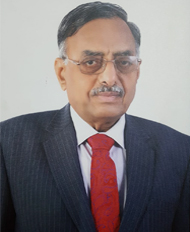Best Practice 1:
1. Title of the Practice : Scholarships for meritorious and needy students
2. Objectives of the Practice
- To enhance accessibility of higher education.
- To reduce dropout rate among students belonging to economically weaker sections of the society
- To encourage meritorious students to pursue higher education
- To encourage achievers in the field of sports & extracurricular activities.
- To assist students belonging to deprived sections of the society to pursue higher education
3. The Context
Accessibility is one of the prime concerns in the field of higher education in our country. This issue needs to be addressed by all the stakeholders. We are aware of the fact that despite measures initiated by the government, Gross Enrolment Ratio (GER) in higher education is only 26% which is far below compared GER in advanced countries. Many dropouts occur from the intermediate level to graduate level due to several reasons, mainly due to financial problems. Realising this fact, the management instituted practice of awarding scholarships and freeships to students belonging to economically weaker sections and deprived sections of the society.
Further, our institution is located at Kempapura, Hebbal, where a sizeable population belong to middle and lower middle class sections of the society. As per the data available with us, about 30% of the parents’ annual income is less than Rs.1 Lakh. Sindhi Seva Samiti started this institution with a philanthropic objective of providing quality education at an affordable cost. It has also inclusive policy as its guiding mandate.
Hence, in order to provide financial assistance to students belonging to economically weaker & deprived sections of the society, the management has taken very conscious decision to provide scholarship to such students.
Besides, encouragement need to be given to merited students and achievers in different fields. Hence, scholarships are also awarded to meritorious students, achievers in sports and extracurricular activities
4. The Practice
At the time of admission, meritorious students are given scholarships based on the percentage of marks scored in the qualifying examination as detailed below:
Merit Scholarship
| % of marks |
% of Scholarship |
| 70% - 79% |
10% |
| 80% - 89% |
20% |
| 90% - 95% |
30% |
| <95% |
40% |
To encourage sports, sports achievers are given scholarship as detailed below:
Sports Scholarship
| Level |
% of Scholarship |
| University / State |
40% |
| National |
50% |
| International |
60% |
Apart from the above, 10% scholarship is given to the students belonging to SC/ST, children of defence personnel & teachers.
Applications for merit-cum-means scholarship are invited from the meritorious & needy students. The management conducts interview along with the parents to assess the needs of the students. The quantum of scholarship is decided by the management casewise.
5. Evidence of Success
Scholarship sanctioned to various categories of students during 2018-19 is detailed below:
| Name /Title of the scheme |
Number of students |
Amount in Rupees |
| MERIT |
313 |
25,42,555 |
| SPORTS |
9 |
3,14,700 |
| MINORITY |
19 |
1,26,790 |
| SINDHI COMMUNITY |
7 |
79,045 |
| SC |
33 |
2,01,990 |
| ST |
12 |
81,150 |
| ECONOMICALLY BACKWARD |
45 |
7,28,930 |
| Total |
438 |
40,75,160 |
The above students, who otherwise would have dropped out from the course, successfully completed the course. We have the satisfaction of providing education to such needy students.
6. Problems Encountered and Resources Required
No problems were encountered
Best Practice 2:
1. Title of the Practice : Curriculum Enrichment through Value Added Programmes
2. Objectives of the Practice
- To provide learner-centric skill oriented programmes
- To enhance competence level and hence employability of students
- To provide knowledge to students in subjects having relevance in the present context
- To provide students an understanding of the expectations and needs of the industry
3. The Context
It is often said by the industrialists & also policy makers that there is a wide gap between what is taught in the classroom & what is required in the industry. Majority of the students passing out of the portals of colleges lack employability skills, as a result of which they find it difficult to get jobs in the market. There is a dire need to bridge this gap. Hence, it is essential for higher educational institutions to supplement/ enrich the curriculum to make the students better prepared to meet the industry needs and develop their own interest and aptitude as well. Keeping this in mind, the management has decided to conduct value added / certificate programmes at their expense. The duration of the course is about 30-40 hours of instruction.
4. The Practice
Every year, before finalising the value added programmes (VAP) for the year, a detailed study is made by the Heads of the Departments & the Faculty by consulting peers, employers, alumni& students. Based on these consultations, value added programmes are selected having relevance to the discipline.
Service providers having the requisite expertise are identified & MOUs signed. Syllabi are prepared jointly by the service provider & the faculty. Classes pertaining to value added programmes are conducted either before or after the class hours or during the semester breaks.
5. Evidence of Success
During 2018-19 the following value added programmes were conducted. The details are as follows:
| Name of the Certificate Course |
Duration |
| Core Java and Webdesign |
40HRS |
| PCB Designing & Prototyping |
15 HRS |
| Python Programming- |
15 HRS |
| ERP-SAP |
40 HRS |
| IBM Analytics |
40 HRS |
| Dot Net |
40 HRS |
| Campus Recruitment Training Programe |
40 HRS |
| Tally ERP 9.0 |
40 HRS |
| Digital marketing |
40 HRS |
| CCNA Training |
40 HRS |
| Network Security |
40 HRS |
| Business English Certificate(BEC)- (for PG students) |
36 HRS |
As a result of these programmes, it is noticed that placements level improved. Out of 130 students, who opted for placements, 93 students were placed (72%)
6. Problems Encountered and Resources Required
It was really difficult to make the students attend these value added programmes. Attendance had to be made compulsory & lot of counselling had to be done to convince the students to attend the classes. We were able to overcome this problem as evidenced by the fact that about 90% of the students attended the programmes. These students were benefitted by getting selected in campus placements.
Financial resources required for the success of the scheme was met by the management.


 Good academic ambience conducive to nurture thinking and learning
Good academic ambience conducive to nurture thinking and learning
 World-class Auditorium and Indoor Sports stadium
World-class Auditorium and Indoor Sports stadium
 Guest lectures, Workshops, Seminars, FDPs & MDPs
Guest lectures, Workshops, Seminars, FDPs & MDPs
 Dedicated Placement wing
Dedicated Placement wing
 Curriculum Enrichment Courses and Activities
Curriculum Enrichment Courses and Activities
 Excellent Student Support Services
Excellent Student Support Services
 Industrial tour / Education tour
Industrial tour / Education tour
 Parking Facilities
Parking Facilities
 Industry-Institute Interactive Programme
Industry-Institute Interactive Programme
 Internship with Industries
Internship with Industries
 Wi-Fi Facility
Wi-Fi Facility
 Career Counselling Sessions by Industry Experts
Career Counselling Sessions by Industry Experts
 Well Stocked Library
Well Stocked Library
 Exclusively Structured Soft Skills and Personality Development Programmes
Exclusively Structured Soft Skills and Personality Development Programmes
 Development through Social Conscience
Development through Social Conscience
 NSS and NCC Wings
NSS and NCC Wings
 Merit and Sports Scholarships
Merit and Sports Scholarships

 Apply Now
Apply Now